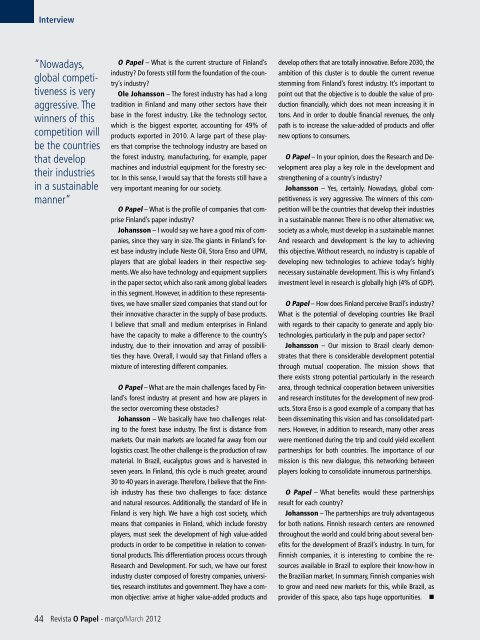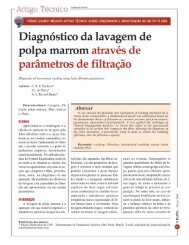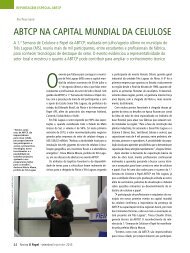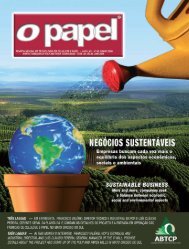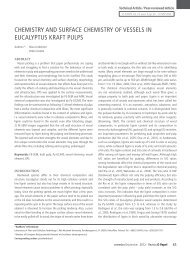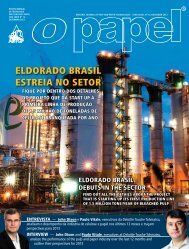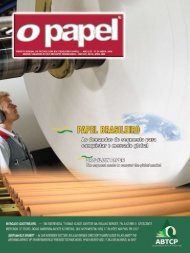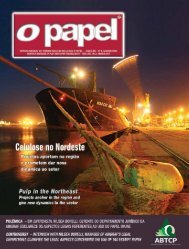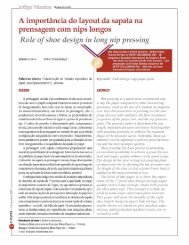BIOECONOMIA - Revista O Papel
BIOECONOMIA - Revista O Papel
BIOECONOMIA - Revista O Papel
You also want an ePaper? Increase the reach of your titles
YUMPU automatically turns print PDFs into web optimized ePapers that Google loves.
Interview<br />
“Nowadays,<br />
global competitiveness<br />
is very<br />
aggressive. The<br />
winners of this<br />
competition will<br />
be the countries<br />
that develop<br />
their industries<br />
in a sustainable<br />
manner”<br />
O <strong>Papel</strong> – What is the current structure of Finland’s<br />
industry Do forests still form the foundation of the country’s<br />
industry<br />
Ole Johansson – The forest industry has had a long<br />
tradition in Finland and many other sectors have their<br />
base in the forest industry. Like the technology sector,<br />
which is the biggest exporter, accounting for 49% of<br />
products exported in 2010. A large part of these players<br />
that comprise the technology industry are based on<br />
the forest industry, manufacturing, for example, paper<br />
machines and industrial equipment for the forestry sector.<br />
In this sense, I would say that the forests still have a<br />
very important meaning for our society.<br />
O <strong>Papel</strong> – What is the profile of companies that comprise<br />
Finland’s paper industry<br />
Johansson – I would say we have a good mix of companies,<br />
since they vary in size. The giants in Finland’s forest<br />
base industry include Neste Oil, Stora Enso and UPM,<br />
players that are global leaders in their respective segments.<br />
We also have technology and equipment suppliers<br />
in the paper sector, which also rank among global leaders<br />
in this segment. However, in addition to these representatives,<br />
we have smaller sized companies that stand out for<br />
their innovative character in the supply of base products.<br />
I believe that small and medium enterprises in Finland<br />
have the capacity to make a difference to the country’s<br />
industry, due to their innovation and array of possibilities<br />
they have. Overall, I would say that Finland offers a<br />
mixture of interesting different companies.<br />
O <strong>Papel</strong> – What are the main challenges faced by Finland’s<br />
forest industry at present and how are players in<br />
the sector overcoming these obstacles<br />
Johansson – We basically have two challenges relating<br />
to the forest base industry. The first is distance from<br />
markets. Our main markets are located far away from our<br />
logistics coast. The other challenge is the production of raw<br />
material. In Brazil, eucalyptus grows and is harvested in<br />
seven years. In Finland, this cycle is much greater, around<br />
30 to 40 years in average. Therefore, I believe that the Finnish<br />
industry has these two challenges to face: distance<br />
and natural resources. Additionally, the standard of life in<br />
Finland is very high. We have a high cost society, which<br />
means that companies in Finland, which include forestry<br />
players, must seek the development of high value-added<br />
products in order to be competitive in relation to conventional<br />
products. This differentiation process occurs through<br />
Research and Development. For such, we have our forest<br />
industry cluster composed of forestry companies, universities,<br />
research institutes and government. They have a common<br />
objective: arrive at higher value-added products and<br />
develop others that are totally innovative. Before 2030, the<br />
ambition of this cluster is to double the current revenue<br />
stemming from Finland’s forest industry. It’s important to<br />
point out that the objective is to double the value of production<br />
financially, which does not mean increasing it in<br />
tons. And in order to double financial revenues, the only<br />
path is to increase the value-added of products and offer<br />
new options to consumers.<br />
O <strong>Papel</strong> – In your opinion, does the Research and Development<br />
area play a key role in the development and<br />
strengthening of a country’s industry<br />
Johansson – Yes, certainly. Nowadays, global competitiveness<br />
is very aggressive. The winners of this competition<br />
will be the countries that develop their industries<br />
in a sustainable manner. There is no other alternative: we,<br />
society as a whole, must develop in a sustainable manner.<br />
And research and development is the key to achieving<br />
this objective. Without research, no industry is capable of<br />
developing new technologies to achieve today’s highly<br />
necessary sustainable development. This is why Finland’s<br />
investment level in research is globally high (4% of GDP).<br />
O <strong>Papel</strong> – How does Finland perceive Brazil’s industry<br />
What is the potential of developing countries like Brazil<br />
with regards to their capacity to generate and apply biotechnologies,<br />
particularly in the pulp and paper sector<br />
Johansson – Our mission to Brazil clearly demonstrates<br />
that there is considerable development potential<br />
through mutual cooperation. The mission shows that<br />
there exists strong potential particularly in the research<br />
area, through technical cooperation between universities<br />
and research institutes for the development of new products.<br />
Stora Enso is a good example of a company that has<br />
been disseminating this vision and has consolidated partners.<br />
However, in addition to research, many other areas<br />
were mentioned during the trip and could yield excellent<br />
partnerships for both countries. The importance of our<br />
mission is this new dialogue, this networking between<br />
players looking to consolidate innumerous partnerships.<br />
O <strong>Papel</strong> – What benefits would these partnerships<br />
result for each country<br />
Johansson – The partnerships are truly advantageous<br />
for both nations. Finnish research centers are renowned<br />
throughout the world and could bring about several benefits<br />
for the development of Brazil’s industry. In turn, for<br />
Finnish companies, it is interesting to combine the resources<br />
available in Brazil to explore their know-how in<br />
the Brazilian market. In summary, Finnish companies wish<br />
to grow and need new markets for this, while Brazil, as<br />
provider of this space, also taps huge opportunities. •<br />
44 <strong>Revista</strong> O <strong>Papel</strong> - março/March 2012


